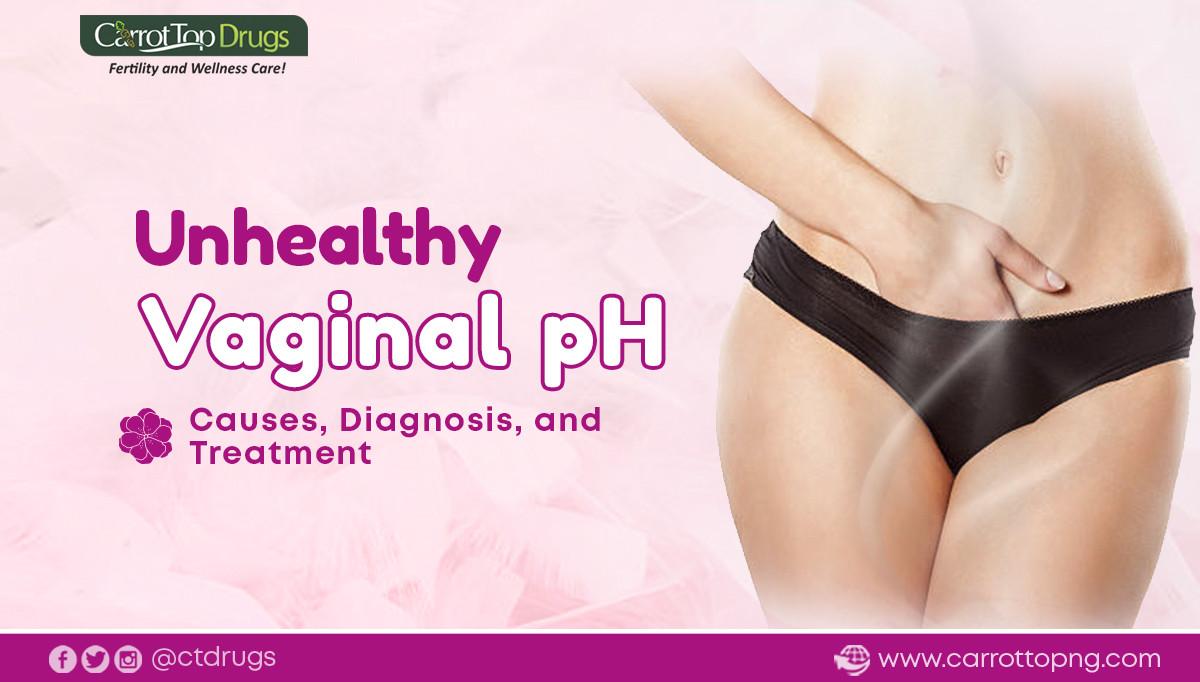Introduction
When it comes to women’s health, maintaining a balanced vaginal pH is crucial. The vaginal pH refers to the level of acidity or alkalinity in the vagina, which is typically acidic in nature. An unhealthy vaginal pH can lead to various discomforting symptoms and increase the risk of infections. In this article, we will explore the causes, symptoms, diagnosis, and treatment options for unhealthy vaginal pH, along with essential prevention tips.
Understanding Vaginal pH
The vagina naturally maintains an acidic pH level, typically ranging between 3.5 and 4.5. This acidic environment is essential for maintaining a healthy balance of bacteria and preventing the overgrowth of harmful microorganisms. The acidic pH helps to inhibit the growth of pathogens and provides protection against infections.
The Importance of a Balanced Vaginal pH for Female Fertility
When it comes to female fertility, maintaining a balanced vaginal pH is of utmost importance. The vaginal environment plays a crucial role in supporting conception and ensuring the health of the reproductive system. In this section, we will explore the significance of a balanced vaginal pH in relation to female fertility.
Creating an Optimal Environment
A balanced vaginal pH creates an optimal environment for sperm survival and motility. The acidic nature of the vagina, typically ranging between 3.5 and 4.5 pH, helps to protect against harmful bacteria and infections while promoting the growth of beneficial bacteria, particularly lactobacilli. This acidic environment provides a natural barrier against pathogens and supports the survival of sperm as they travel through the reproductive tract.
Sperm Viability and Motility
The acidity of the vagina plays a crucial role in maintaining the viability and motility of sperm. Sperm are highly sensitive to pH changes, and an imbalanced vaginal pH can negatively affect their health and movement. If the vaginal pH becomes too alkaline (unhealthy vaginal pH), it can impair sperm motility and reduce their ability to reach and fertilize the egg.
Preventing Infections
An unhealthy vaginal pH can increase the risk of infections, such as bacterial vaginosis or yeast infections. These infections can lead to inflammation and disrupt the delicate balance of the vaginal ecosystem. Inflammation can cause damage to the reproductive tissues and impair fertility. By maintaining a balanced vaginal pH, the growth of harmful bacteria and yeast is inhibited, reducing the likelihood of infections and their potential impact on fertility.
Optimizing Cervical Mucus
Cervical mucus plays a vital role in fertility as it helps sperm navigate through the cervix and reach the fallopian tubes where fertilization occurs. A balanced vaginal pH promotes the production of healthy cervical mucus. The consistency and quality of cervical mucus change throughout the menstrual cycle, becoming more receptive and fertile during ovulation. An optimal vaginal pH supports the production of fertile cervical mucus, which provides a favourable medium for sperm transport and enhances their chances of reaching the egg.
Hormonal Balance
Hormonal balance is closely linked to the health of the reproductive system and fertility. Fluctuations in hormonal levels can influence vaginal pH. For example, during menopause, when estrogen levels decline, the vaginal pH can become less acidic (unhealthy vaginal pH), leading to an increased risk of infections and discomfort. By maintaining a balanced vaginal pH, the risk of hormonal imbalances affecting fertility can be reduced.
Maintaining a Healthy Microbiome
A balanced vaginal pH is closely associated with a healthy vaginal microbiome. The presence of beneficial bacteria, particularly lactobacilli, helps to maintain the acidic pH and prevent the overgrowth of harmful bacteria. A disrupted vaginal pH can lead to an imbalance in the microbiome, known as dysbiosis, which can negatively impact fertility. By promoting a balanced vaginal pH, the growth of beneficial bacteria is encouraged, supporting a healthy microbiome and fertility.
Causes of Unhealthy Vaginal pH
Several factors can contribute to an unhealthy vaginal pH:
Poor Vaginal Hygiene Causes Unhealthy Vaginal pH
Maintaining good vaginal hygiene is essential for promoting a healthy vaginal pH and overall vaginal health. Poor vaginal hygiene practices can disrupt the delicate balance of the vaginal ecosystem, leading to an unhealthy vaginal pH. In this section, we will explore how poor vaginal hygiene can contribute to an imbalanced vaginal pH and the associated risks.
1. Improper Cleansing
Improper cleansing of the vaginal area is a common cause of unhealthy vaginal pH. Some individuals may use harsh soaps, scented products, or aggressive cleaning techniques, believing they are maintaining cleanliness. However, these practices can disrupt the natural pH balance of the vagina. Harsh soaps and cleansers can strip away the protective layer of natural oils and beneficial bacteria, leaving the vaginal environment susceptible to imbalances and infections.
2. Excessive Douching
Douching is the practice of rinsing the vagina with water or other solutions. Many women believe that douching helps to keep the vagina clean and fresh. However, douching is unnecessary and can actually be harmful. The vagina is self-cleaning and has its own mechanisms to maintain a healthy pH balance. Douching disrupts this delicate balance by washing away the healthy bacteria and natural fluids that help protect the vagina. This leads to an unhealthy vaginal pH, which results in an increased risk of infections and discomfort.
3. Wearing Non-Breathable Fabrics
The choice of underwear can also impact vaginal health and pH balance. Wearing non-breathable fabrics, such as synthetic materials or tight-fitting underwear, can trap moisture and heat in the vaginal area. This environment promotes the growth of bacteria and fungi, leading to an imbalance in vaginal pH. It is recommended to wear breathable fabrics like cotton that allow for air circulation and help keep the vaginal area dry.
4. Insufficient Intimate Hygiene
Inadequate intimate hygiene practices can contribute to an unhealthy vaginal pH. Neglecting to clean the vaginal area regularly or properly can allow the accumulation of sweat, bacteria, and other substances that can disrupt the natural pH balance. It is important to practice gentle and regular cleansing of the external genital area using mild, fragrance-free cleansers and warm water.
Menopause Can Cause Unhealthy Vaginal pH
Menopause is a natural biological process that occurs in women typically around their late 40s or early 50s. During menopause, the body undergoes hormonal changes, particularly a decline in estrogen levels. These hormonal changes can have various effects on the body, including the vaginal environment. In this section, we will explore how menopause can cause an unhealthy vaginal pH and the associated risks.
1. Decline in Estrogen
Estrogen is a hormone that plays a vital role in maintaining the health of the vaginal tissues and the overall vaginal ecosystem. It helps to keep the vaginal lining thick, elastic, and well-lubricated. As women approach menopause, the production of estrogen decreases significantly. The decline in estrogen levels leads to thinning and drying of the vaginal tissues, a condition known as vaginal atrophy.
2. Altered Vaginal pH
Estrogen helps to maintain the acidic pH of the vagina. This acidic environment is important for preventing the overgrowth of harmful bacteria and maintaining a healthy vaginal microbiome. However, with the decline in estrogen during menopause, the vaginal pH can become less acidic, approaching a more neutral or even alkaline pH. This shift in pH creates an environment that is less protective against infections and imbalances.
Hormonal Imbalance Causes Unhealthy Vaginal pH
Hormones play a crucial role in maintaining the overall health and functioning of the body, including the vaginal environment. Hormonal imbalances can disrupt the delicate balance of the vaginal pH, leading to an unhealthy vaginal environment. In this section, we will explore how hormonal imbalance can cause an unhealthy vaginal pH and the associated risks.
1. Effects of Estrogen Imbalance
An imbalance in estrogen levels can have significant effects on the vaginal environment. When estrogen levels are low, as in certain phases of the menstrual cycle or during menopause, the vaginal tissues may become thinner, drier, and less elastic. This can lead to vaginal dryness, discomfort, and an increased risk of infections. The decline in estrogen levels can also contribute to an elevation in vaginal pH, making it more alkaline and less conducive to a healthy vaginal microbiome.
2. Effects of Progesterone Imbalance
Progesterone imbalance, although less directly linked to vaginal pH, can still impact vaginal health. Progesterone dominance, commonly experienced during certain phases of the menstrual cycle or in conditions like polycystic ovary syndrome (PCOS), can affect vaginal pH.
Signs and Symptoms of Unhealthy Vaginal pH
Recognizing the signs of an unhealthy vaginal pH can help you seek appropriate treatment. The following symptoms may indicate an imbalance:
Vaginal Discharge: Unusual or excessive discharge that may be thick, watery, or clumpy.
Odor: A strong, unpleasant odor, often described as fishy or foul-smelling.
Itching and Irritation: Persistent itching, redness, and irritation in and around the vaginal area.
Discomfort During Sex: Pain or discomfort during sexual intercourse, often accompanied by dryness.
Diagnosing Vaginal pH Imbalance
If you suspect an unhealthy vaginal pH, there are a few ways to diagnose the imbalance:
pH Testing Kits:
Over-the-counter pH testing kits are available that allow you to measure the acidity of your vaginal pH at home. These kits typically include pH test strips that change color based on the pH level.
Doctor’s Examination:
If you’re experiencing persistent symptoms or are unsure about the cause, it’s recommended to consult a healthcare professional. They can perform a physical examination and take a swab sample to test the vaginal pH in a laboratory setting.
Treatment Options for Unhealthy Vaginal pH
Fortunately, there are various treatment options available to restore a healthy vaginal pH:
Treating Unhealthy Vaginal pH with Good Hygiene Practices
Maintaining good hygiene practices is crucial for treating and restoring a healthy vaginal pH. Proper hygiene can help restore the natural balance of the vaginal ecosystem, reduce the risk of infections, and promote overall vaginal health. In this section, we will explore how good hygiene practices can effectively treat unhealthy vaginal pH.
1. Gentle Cleansing
Use mild, fragrance-free soap or a specifically formulated pH-balanced cleanser to cleanse the vulva and the external parts of the vagina.
2. Proper Wiping Technique
Always wipe from front to back, moving away from the urethra and vaginal area. This helps to prevent the transfer of bacteria from the anal region to the vagina, reducing the risk of urinary tract infections (UTIs) and other infections.
3. Wear Breathable Underwear
Cotton allows for better airflow and moisture absorption, reducing the risk of excessive moisture and the growth of harmful bacteria.
4. Avoid Harsh Chemicals
When it comes to vaginal hygiene, it’s important to avoid using harsh chemicals or products that can disrupt the natural pH balance. This includes avoiding scented pads, tampons, and panty liners, as well as intimate sprays or powders.
5. Regular Changing of Menstrual Products
Prolonged use of tampons or pads can create a moist environment that promotes bacterial growth. Change tampons (sanitary pads) every 4 to 6 hours, or as needed, and avoid leaving pads on for extended periods.
6. Proper Intimate Care After Sexual Activity
Gently wash the genital area with warm water or a mild cleanser to remove any residual lubricants, semen, or other substances that may have been introduced during sexual activity.
7. Avoid Excessive Cleaning or Douching
The vagina is self-cleaning and has a delicate balance of natural bacteria that help maintain a healthy pH. Excessive cleaning or douching can disrupt this balance, leading to imbalances, infections, and other complications.
8. Maintain a Healthy Lifestyle
Stay hydrated, follow a balanced diet rich in nutrients, and engage in regular exercise. A healthy lifestyle can support overall vaginal health and enhance the body’s natural defences against imbalances and infections.
Probiotics and Prebiotics:
Probiotics, such as lactobacilli, are beneficial bacteria that help maintain a healthy vaginal pH. They can be taken orally or applied topically in the form of suppositories or creams. Prebiotics, which are substances that promote the growth of healthy bacteria, can also be beneficial against unhealthy vaginal pH.
pH-Balancing Products:
pH-Balancing Products
Several products are available, such as vaginal gels or suppositories, designed to restore the vaginal pH balance. These products often contain ingredients like boric acid, lactic acid, or hydrogen peroxide.
In order to prevent unhealthy vaginal pH, we also recommend our Evergreen CM. It helps to balance the pH of the vagina and serves as an antioxidant support for the sperm cells.
Prescription Medications for Treating Unhealthy Vaginal pH
In cases where other treatments have proven ineffective or when the condition of unhealthy vaginal pH is severe, healthcare professionals may prescribe specific medications to address the underlying infection or restore the vaginal pH balance. Prescription medications, such as antibiotics or antifungal agents, can be instrumental in treating the condition effectively and promoting a healthy vaginal environment.
1. Antibiotics:
Antibiotics are commonly prescribed to combat bacterial infections that may contribute to an imbalanced vaginal pH. When harmful bacteria, such as those causing bacterial vaginosis, overgrow in the vagina, antibiotics can help eliminate them and restore a healthier balance. By targeting and eradicating the problematic bacteria, antibiotics play a crucial role in rebalancing the vaginal microbiome and reestablishing a normal pH level.
2. Antifungal Agents:
Antifungal medications are typically prescribed when a yeast infection, known as vaginal candidiasis, is the underlying cause of an unhealthy vaginal pH. These medications come in various forms, including oral tablets, creams, suppositories, or vaginal tablets. This helps alleviate symptoms such as itching, discharge, and discomfort while promoting the growth of beneficial bacteria.
3. Hormonal Therapy:
In some cases, hormonal imbalances can contribute to unhealthy vaginal pH, particularly in postmenopausal women experiencing vaginal atrophy due to reduced estrogen levels. Hormonal therapy may be recommended to restore the hormonal balance and promote vaginal health. This can involve systemic estrogen replacement therapy or localized treatments such as vaginal creams, rings, or tablets.
Conclusion
Maintaining a balanced vaginal pH is crucial for women’s overall vaginal health. By understanding the causes, symptoms, and treatment options for unhealthy vaginal pH, along with preventive measures, women can take control of their vaginal health and prevent potential complications. Remember, if you have concerns about your vaginal pH or experience persistent symptoms, it’s best to consult a healthcare professional for personalized advice and guidance.
FAQs
Can using scented products cause an unhealthy vaginal pH?
Using scented products, such as perfumed soaps or body washes, can disrupt the natural balance of the vaginal pH. These products often contain harsh chemicals that can irritate the sensitive vaginal tissues and alter the pH level.
Is it normal to have some vaginal odor?
It’s normal for the vagina to have a mild odor, which can vary from person to person.
Can hormonal changes affect vaginal pH?
Yes, hormonal changes can influence vaginal pH.
Can using probiotics help restore a healthy vaginal pH?
Yes, using probiotics can be beneficial in restoring a healthy vaginal pH.
Are there any natural remedies for maintaining a healthy vaginal pH?
While maintaining good hygiene practices and following a healthy lifestyle are important, some natural remedies may help support a healthy vaginal pH. These include consuming probiotic-rich foods like yoghurt, maintaining a balanced diet with plenty of fruits and vegetables, and avoiding irritants like harsh soaps or douches.

















